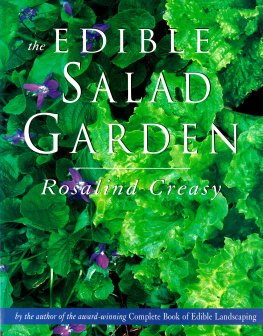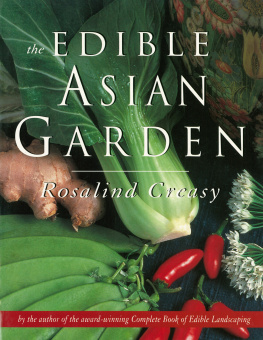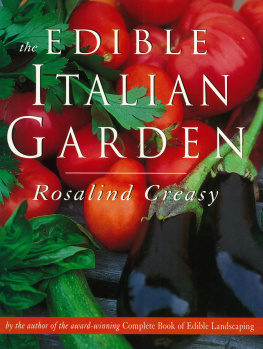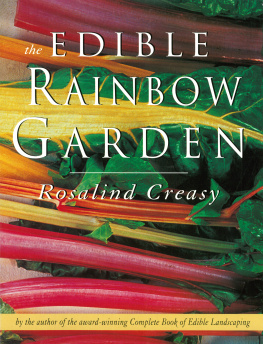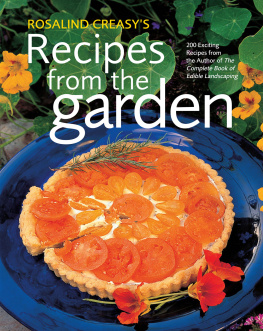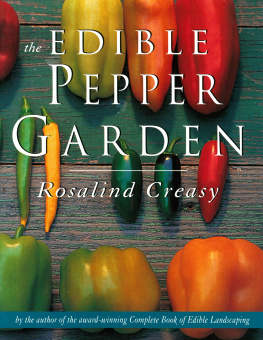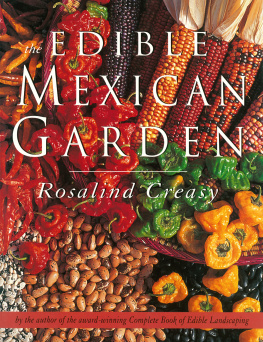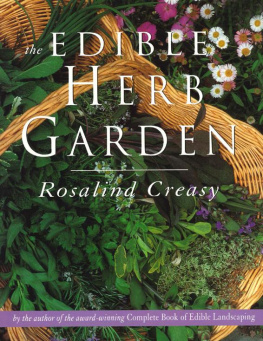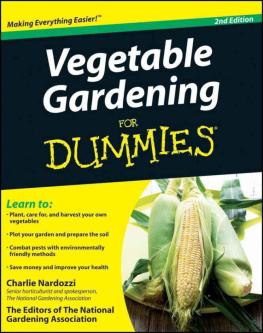acknowledgments
M y garden is the foundation for my books, photography, and recipes. For nearly twelve months of the year we toil to keep it beautiful and bountiful. Unlike most gardens, as it is a photo studio and trial plot, it must look glorious, be healthy, and produce for the kitchen. To complicate the maintenance, all the beds are changed at least twice a year. Needless to say it is a large undertaking. For two decades a quartet of talented organic gardener/cooks have not only given it hundreds of hours of loving attention, but they have also been generous with their vast knowledge of plants. Together we have forged our concept of gardening and cooking, much of which I share with you in this series of garden cookbooks.
I wish to thank Wendy Krupnick for giving the garden such a strong foundation and Joe Queirolo for maintaining it for many years and lending it such a gentle and sure hand. For the last decade Jody Main and Duncan Minalga have helped me expand my garden horizons. No matter how complex the project they enthusiastically rise to the occasion.
In the kitchen, I am most fortunate to have Gudi Riter, a very talented cook who developed many of her skills in Germany and France. I thank her for the help she provides as we create recipes and present them in all their glory.
I want to thank Carole Saville who has generously shared her vast knowledge of herbs and given me a firm footing. Over the years we have collaborated on magazine columns and books, and much of her talent appears in these pages. Herbs have different requirements, depending on the climate in which they are grown. I depend on herb mavens; Rose Marie Nichols McGee of Nichols Garden Nursery in Oregon, Jim Wilson in South Carolina, Madeline Hill and Gwen Barkley in Texas, Louise Hyde at Well-Sweep Herb Farm in New Jersey, Lucinda Hutson in Texas, and Ron Zimmerman in Washington for their expertise, and I thank them for sharing their gardens.
I thank Dayna Lane for her steady hand and editorial assistance. In addition to day-to-day compilations, she joins me on our constant search for the most effective organic pest controls, superior herb varieties, and the best sources for plants.
I would also like to thank a large supporting cast: my husband Robert who gives such quality technical advice and loving support; my daughter-in-law Julie Creasy who is always available for recipe testing or a photo shoot; Nancy Favier for her occasional help in the garden and office; Jesse Cool, owner of Flea Street Cafe in California, for her wonderful recipes; Renee Shepherd of Renees Garden, and Cathy Barash, editor of Meredith Books, for sharing her information and enthusiasm; Jane Whitfield, Linda Gunnarson, and David Humphrey, who were integral to the initial vision of this book; Kathryn Sky-Peck for providing the style and quality of the layout; and Marcie Hawthorne for the lovely drawings. Heartfelt thanks to Eric Oey and to the entire Periplus staff, especially Deane Norton and Sonia MacNeil, for their help. Finally, I would like to thank my editor, Isabelle Bleecker, for her gentle guidance, attention to detail, and thoughtful presence.
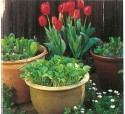
appendix A planting and maintenance
C overed in this section are the basics of planning a salad garden, soil preparation, starting seeds, transplanting, fertilizing, composting, cold frames, crop rotation, mulching, watering and irrigation, and maintaining salad greens.
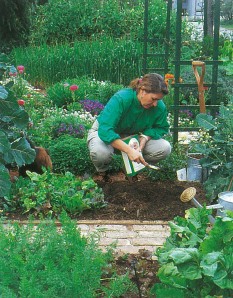
Planning Your Salad Garden
The first step in planning your garden is choosing a suitable site. Most chefs recommend locating the edible garden as close to the kitchen as possible, and I heartily agree. Beyond that, the majority of salad greens need at least six hours of sun (eight is better) except in warm humid areas when afternoon or filtered shade is best, and good drainage. There are only a few salad greens that tolerate much shade: sorrel, cress, arugula, and some of the wild greens. Salad greens need fairly rich soil with lots of added organic matter. They can be planted in rows or in a bed by themselvesas part of the classic vegetable garden, say; some of them, especially Swiss chard, orach, Japanese red mustard, mizuna, and amaranths, are beautiful and work well interplanted in a flower bed with annual flowers, most of which need the same conditions. In addition, all salad greens can be grown in containers or in large planter boxes.
Once youve decided on where you are going to plant, its time to choose your greens. Your major consideration will be, of course, what flavors you enjoy using in the kitchen. With this in mind, look for species and varieties that will grow well in your climate. As a rule, gardeners in northern climates and high elevations need vegetables that tolerate cool and/or short summer conditions. Salad greens are great for these conditions. Gardeners in hot, humid areas require plants that tolerate diseases well and need to consider carefully how to work around the high summer heat.
The USDA Plant Hardiness Zone map has designated eleven zones according to winter lows. These demarcations are a help when youre choosing perennial plants but of only limited use for selecting annual plants like salad greens. The map in the new Sunset National Garden Book gives more detailed climatic information; it divides the continent into forty-five growing zones and describes the temperature ranges and growing season in much detail. Of additional interest to the salad gardener is the Heat Map, published by the American Horticultural Society, which details twelve zones that indicate the average number of days each year when a given area experiences temperatures of 86Fthe temperature at which many plants, including most salad greens, begin to suffer physiological damage. In the Encyclopedia of Salad Greens youll find information on greens that have a low tolerance to high temperatures and those that grow well in hot weather. See the Bibliography (page ) for information on obtaining the Heat Map.
In addition to analyzing your climate, knowing what type of soil a particular salad green needs is equally important. Consider how well your soil drains: is the soil rich with organic matter and fertility? Poor with bad drainage? So sandy that few plants grow well? Find out too what your soil pH is; nurseries have kits to test your soils pH, and University Extension Services can lead you to sources of soil tests and soil experts. As a rule, rainy climates have acidic soils that need the pH raised, and arid climates have fairly neutral or alkaline soils that need extra organic matter to lower the pH. Most salad greens grow best in soil with a pH about 6.5in other words, slightly acidic soil. Soils that are below 6 tie up phosphorus, potassium, and calcium, making these elements unavailable to plants, and soils with a pH much over 6.5 tie up iron and zinc. Further, is there hardpan under your garden that prevents roots from penetrating the soil, or water from draining? This is a fairly common problem in areas of heavy clay. You need answers to these basic questions before you proceed because to be tender and mild, salad greens need to grow fast and with little stress. Salad greens do best with good drainage. Their roots need air, and if the soil stays waterlogged for long, roots suffocate or are prone to root rot. If you are unsure of how well a particular area in your garden drains, dig a hole about 10 inches deep and 10 inches across and fill it with water. The next day fill it againif it still has water in it eight to ten hours later, you need to find another place in the garden that will drain much faster, amend your soil with much organic matter and mound it up at least six to eight inches above the ground level, or grow your salad greens in containers.

